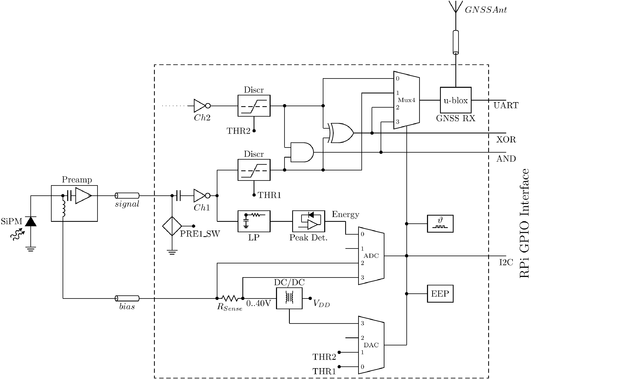Muonpi board
The MuonPi board is designed as plug-on board for the Raspberry Pi B+ in a form factor conforming with the RPi HAT specifications.
Functional Description
The MuonPi board implements following functionalities:
- Two input channels
- Supply voltage for remote powering the preamplifier through the signal line: The voltage can be switched on/off through a GPIO signal (individually for the two channels). It includes overcurrent and overtemperature shutdown and a fault signal.
- Bias voltage supply for the SiPM sensor and bias voltage/current supervision. A DC/DC converter generates the required reverse biasing voltage from the RPi 5V rail. The voltage can be switched on/off through a GPIO signal. Actual bias voltage and current are measured through the on-board ADC. The voltage can be controled through the on-board DAC (not in HW version 2).
- Optional inverter for the two signal inputs (mounting option) in case negative signals are presented to the board
- Threshold discriminators with adjustable thresholds (DAC channels 1 and 2) in the range from 0.5 mV to 3V. The discriminator outputs are LVCMOS signals with a length of ~100 ns.
- Both channels are logically connected by one AND gate and one XOR gate. In this way, a coincidence ("both at the same time") as well as an anti-coincidence ("only exactly one") within a 100 ns time window can be asserted.
- The two gate signals (AND/XOR) are time-shaped to 1 us length and provided to the GPIO interface of the RPi
- The two discriminator signals and the two logic gate signals are fed to a multiplexer. Its output is fed to the time stamping input of the u-blox GNSS receiver.
- The u-blox GNSS receiver NEO-M8N is utilized to get the precise time and frequency reference in order to provide a sufficient precision of the time stamping on the nanosecond level. The time stamp of an event (leading and trailing edges of the signal present at the multiplexer output) is transmitted to the RPi via UART interface through the UBX-TIM-TM2 message.
Detailed Description
The MuonPi board design is open hardware. It is entirely defined in the free EDA cloud tool EasyEDA. The current working version of the design is HW Ver 2 which is explained in detail here. For the predecessor version (HW Ver 1) follow this link.
